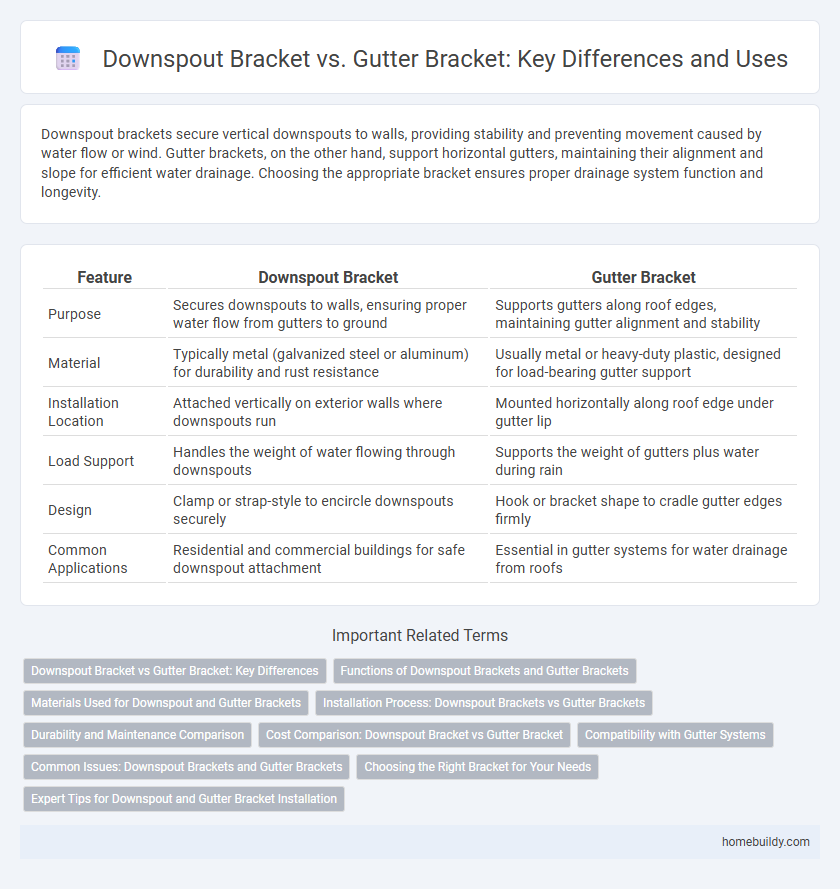Downspout brackets secure vertical downspouts to walls, providing stability and preventing movement caused by water flow or wind. Gutter brackets, on the other hand, support horizontal gutters, maintaining their alignment and slope for efficient water drainage. Choosing the appropriate bracket ensures proper drainage system function and longevity.
Table of Comparison
| Feature | Downspout Bracket | Gutter Bracket |
|---|---|---|
| Purpose | Secures downspouts to walls, ensuring proper water flow from gutters to ground | Supports gutters along roof edges, maintaining gutter alignment and stability |
| Material | Typically metal (galvanized steel or aluminum) for durability and rust resistance | Usually metal or heavy-duty plastic, designed for load-bearing gutter support |
| Installation Location | Attached vertically on exterior walls where downspouts run | Mounted horizontally along roof edge under gutter lip |
| Load Support | Handles the weight of water flowing through downspouts | Supports the weight of gutters plus water during rain |
| Design | Clamp or strap-style to encircle downspouts securely | Hook or bracket shape to cradle gutter edges firmly |
| Common Applications | Residential and commercial buildings for safe downspout attachment | Essential in gutter systems for water drainage from roofs |
Downspout Bracket vs Gutter Bracket: Key Differences
Downspout brackets secure vertical downspouts to a building, ensuring stability and proper water flow, while gutter brackets attach horizontal gutters to eaves or fascia. Downspout brackets are typically designed to handle vertical loads and resist wind pressure, whereas gutter brackets support the weight of collected water and debris along the gutter line. Material composition and installation methods differ markedly between downspout and gutter brackets, reflecting their unique functional roles in rainwater management systems.
Functions of Downspout Brackets and Gutter Brackets
Downspout brackets secure downspouts to the building, ensuring proper water channeling away from the foundation and preventing leaks or structural damage. Gutter brackets, on the other hand, support gutters by attaching them firmly to the roof edge, maintaining gutter alignment and preventing sagging under water or debris weight. Both types of brackets play essential roles in effective rainwater management, with downspout brackets focusing on vertical drainage stability and gutter brackets emphasizing horizontal support.
Materials Used for Downspout and Gutter Brackets
Downspout brackets are typically made from durable materials like galvanized steel, aluminum, or heavy-duty plastic, chosen for their ability to withstand outdoor weather conditions and support vertical water flow. Gutter brackets often utilize similar materials but may also incorporate stainless steel for enhanced rust resistance due to their horizontal positioning and increased exposure to debris accumulation. The material selection directly impacts the longevity and stability of both downspout and gutter brackets, with metal options generally preferred for heavy-duty applications.
Installation Process: Downspout Brackets vs Gutter Brackets
Downspout brackets are typically installed by securing them vertically along the downspout using screws or straps to ensure proper water flow management. In contrast, gutter brackets require horizontal placement underneath the gutter lip, often involving precise alignment with roof edges for optimal support. The installation process for downspout brackets is generally simpler, focusing on stability and drainage efficiency, whereas gutter brackets demand careful measurement to maintain gutter slope and prevent pooling.
Durability and Maintenance Comparison
Downspout brackets are typically made from heavy-duty materials like galvanized steel or aluminum, offering superior resistance to weather-induced wear compared to gutter brackets, which are often lighter and less robust. The enhanced durability of downspout brackets reduces the frequency of maintenance and replacement, ensuring longer-lasting support for drainage systems. Maintenance for downspout brackets generally involves less frequent inspections and cleanings, whereas gutter brackets may require more regular upkeep due to their exposure to debris and water flow.
Cost Comparison: Downspout Bracket vs Gutter Bracket
Downspout brackets typically cost less than gutter brackets due to their simpler design and lower material requirements. Gutter brackets require more durable construction to support larger volumes of water, leading to higher prices per unit. Considering installation expenses, downspout brackets often result in reduced overall costs for maintaining effective rainwater drainage systems.
Compatibility with Gutter Systems
Downspout brackets are specifically designed to secure downspouts and are compatible with a wide range of gutter systems, ensuring effective water channeling from roof edges to ground drainage. Gutter brackets, however, primarily support the gutter trough itself and must match the gutter profile for optimal fit and stability. Selecting brackets that correspond precisely to your gutter system's dimensions and material enhances durability and prevents water damage caused by misalignment or improper installation.
Common Issues: Downspout Brackets and Gutter Brackets
Downspout brackets and gutter brackets often face common issues such as rusting, loosening, and improper installation that compromise their effectiveness in water drainage systems. Downspout brackets typically endure more stress due to vertical water flow, leading to potential bending or detachment, while gutter brackets may struggle with heavy debris accumulation and weight strain. Proper material selection and secure fastening are critical to preventing these problems and extending the lifespan of both downspout and gutter brackets.
Choosing the Right Bracket for Your Needs
Downspout brackets are specifically designed to securely hold vertical downspouts in place, providing stability against wind and water pressure, whereas gutter brackets support horizontal gutters along the roofline. When choosing the right bracket, consider the material compatibility, load-bearing capacity, and climate conditions to ensure durability and effective water drainage. Selecting a bracket tailored to either downspouts or gutters prevents structural damage and maintains the integrity of the entire rainwater management system.
Expert Tips for Downspout and Gutter Bracket Installation
Downspout brackets securely fix downspouts to a building, ensuring proper water drainage while withstanding external forces like wind and snow. Expert tips for installation emphasize aligning brackets with downspout seams and spacing them every 3 to 4 feet to prevent sagging and maintain structural integrity. Gutter brackets, on the other hand, focus on supporting gutter channels and require precise placement along the fascia to ensure correct slope and optimal water flow toward downspouts.
Downspout bracket vs Gutter bracket Infographic

 homebuildy.com
homebuildy.com